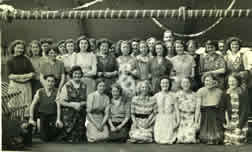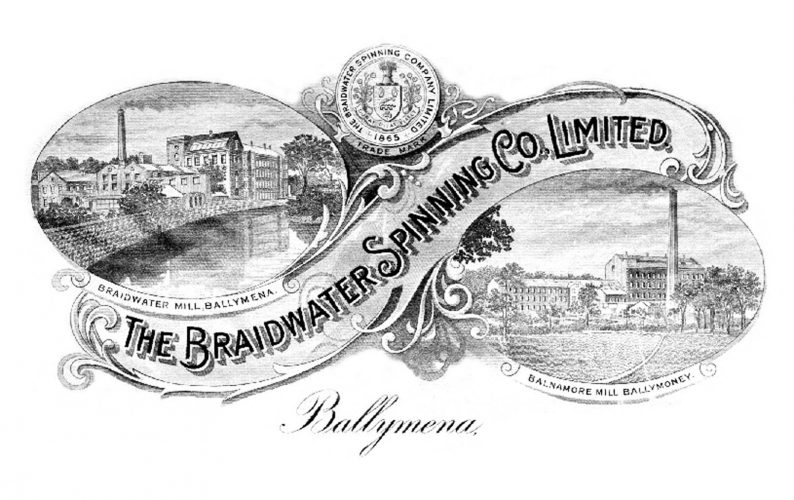Welcome to Balnamore

Dervock: get involved!
20th March 2019
The Balnamore Mill Horn
20th March 2019Welcome to Balnamore
Evidence of linen production in Balnamore goes back to 1764, when John Caldwell bought a house at ‘Harmony Hill’ and about 40 acres of land, including a corn mill. He built a bleach works beside the corn mill and later added a small beetling mill to process the brown linen cloth being woven in local homes.
John’s sons, Richard and John, were key local figures in the United Irish Rebellion in 1798, and as a result the family home and mills were burned to the ground and the family was forced to emigrate to America. The mill and surrounding lands were bought by Mr Joseph Bryan. In 1809 he received a grant of £600 from the Trustees of the Linen and Hempen Manufacturers of Ireland and bought over 400 water-powered spindles, starting one of the largest flax spinning mills outside the Belfast area.
The mill changed hands on a number of occasions during the 19th century, and continued to expand and prosper, making a strong yarn used for sail cloth and canvas. The corn mill was still in operation and there was also a bleach works, a blacksmith’s and a carpenter’s shop. The growing business attracted some 400 workers, and 52 houses, a school, a shop and a canteen had been built to accommodate them. It was sold to the Braidwater Spinning Company Ltd., of Ballymena, in 1886, which extended the mill and introduced new water-turbines.
In 1920 the mill was sold to Hale Martin and Co. Ltd., which was to be the last owner involved in the production of linen yarn. In the 1930s the linen industry went into decline, and a fire in the main building during World War Two was another major blow for Balnamore Mill. When Managing Director Sir William McCleery died in 1957 the mill was unable to survive without his drive and direction.
On 27th February 1959 the spinning machines came to a halt, the mill horn sounded for the last time and Balnamore village was plunged into unemployment. For a short time the Coleraine firm H&T Bellas Ltd. operated from the site and it was then used as a government store, at one time storing emergency supplies for families affected by the Troubles in Belfast.
‘[In 1917] at the age of twelve, I became what was called a half timer. This meant going to school for three days and working in the mill for the remainder of the week … [You] became a full time worker at the age of fourteen. The wages earned were small, in those days, and I collected about 12 shillings, per fortnight.’
Jim Morrison, cager
‘I had a brother Willie, he worked in the machine room, and my brother Hugh he worked there as well. And then I had a sister Maude, she worked in the spinning room. And then the last year before it closed my beloved wife, she worked in the preparing room … Balnamore was a clan of their own, once you were Balnamore you were always Balnamore’
Jock Acheson, tow breaker
 ‘[The spinners wore] an apron, made of a black waterproof material, and over this, a short piece of the same material, called a patch, was also worn. Spinners an doffers carried similar tools, suspended by a cord around the waist, these were a picker, a striker knife and a brush… The cagers wore a blue blouse, called a slope. Around his waist was a ‘bag rubber’, or apron, the ends of which were caught up by string that went round the back of the neck forming a sort of bag. His job was to lift off the full bobbins, and drop them into this ‘bag’. He then filled the bobbins into a cage, which was a shallow box-like receptacle with spike sticking up from the bottom.’
‘[The spinners wore] an apron, made of a black waterproof material, and over this, a short piece of the same material, called a patch, was also worn. Spinners an doffers carried similar tools, suspended by a cord around the waist, these were a picker, a striker knife and a brush… The cagers wore a blue blouse, called a slope. Around his waist was a ‘bag rubber’, or apron, the ends of which were caught up by string that went round the back of the neck forming a sort of bag. His job was to lift off the full bobbins, and drop them into this ‘bag’. He then filled the bobbins into a cage, which was a shallow box-like receptacle with spike sticking up from the bottom.’
Jim Morrison, cager
‘On a working morning, the mill horn – which on a calm day you could’ve heard for miles around – went at a quarter to eight, the first turn, and then again it gave a repeat call at eight o’clock. You made your way to work, started at quarter past, and then when you went on your break, which was at quarter to one, they sounded the horn again at twenty past one … I know for a fact that people working to farmers in different fields around that they used it as a time clock as well. The Balnamore horn was famous just for letting the people know it was twenty past one.’
Jock Acheson, tow breaker
‘I enjoyed my time in the mill, but it would’ve been nicer if you hadn’t had to make your own money. You made maybe 3 pound in the week, it wasn’t bad. Some people had better than others; some people had good spinners and good yarn that never broke. You could’ve done twice as much, it just depended.’
Agnes Boyd, reeler
‘We had a [football] team in the mill, and Sir William [McCleery] provided us with a pitch, the kit and the use of the mill lorry to travel to away matches. We sat in the back of the lorry and a canvas cover over it and away we went. So that was a luxury, having Balnamore’s mobile for travelling in.
Jock Acheson, tow breaker

